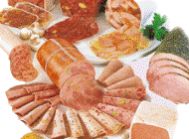 Agra Foods will join other major packaged food manufacturers including Heinz, Kellogg, Nestle USA and General Mills on a $50 million advertising campaign designed to promote a positive image of frozen foods, a sales category that has stalled industrywide.
Agra Foods will join other major packaged food manufacturers including Heinz, Kellogg, Nestle USA and General Mills on a $50 million advertising campaign designed to promote a positive image of frozen foods, a sales category that has stalled industrywide.The campaign will challenge shoppers' thinking that frozen food is fattening and highly processed, which ConAgra's polling shows are beliefs held by the majority of consumers.
ConAgra has a lot at stake in frozen foods. In recent years the Omaha-based packaged food company has expanded its freezer-section offerings both through acquisitions and through adding on to existing brands and product lines. The recent acquisition of Ralcorp store-brand food manufacturer takes ConAgra further into frozen, with new lines of frozen breakfast items, bread and dough.
In the 2012 fiscal year, retail sales of frozen foods made up 15 percent of all ConAgra sales, a value of $2 billion, which does not include any Ralcorp income. But frozen foods were ConAgra's slowest-growing major consumer food category that year, at just 1.3 percent growth, compared with 4.7 percent consumer foods sales growth overall.
IBISWorld estimates ConAgra's frozen sales will show 4 percent growth in its 2013 fiscal year, which ends this month, a figure that would include several newly developed and acquired products not available during some or all of the 2012 year.
Slow or no growth among existing products is a trend seen across the industry.
“It's not that we're not buying frozen foods, it's that we're not buying more frozen foods,” said Harry Balzer, chief industry analyst for the NPD Group.
The manufacturing giants, united as the “Frozen Food Roundtable” through the American Frozen Food Institute industry association, say 98 percent of frozen products have flat or declining sales, according to AdvertisingAge magazine, which obtained proprietary research and advertising proposals from the companies. ConAgra declined to comment for this story. Some product lines are faring worse than others.
Sales of frozen meals, the largest category, fell from 2008 to today, according to a report this month from Mintel, and are expected to continue to slide into 2017, as the economy improves and consumers increase spending on restaurants and home-cooked meals. Slow growth is ahead for frozen snacks and appetizers.
“Brands will have to step up their healthy and flavor offerings to truly recapture interest in the market and reverse the downhill slide,” Mintel concluded.
The research firm said manufacturers will have to focus on healthful products, innovate on convenience and speed and create more restaurant-style appetizers to offer an alternative to eating out.
One of the fastest-growing categories is frozen hand-held food, such as breakfast sandwiches and burritos. People who buy these products tend to be more interested in convenience and price than in health benefits, Mintel said.
Many factors are working against growth in frozen food, according to market research firm Packaged Facts.
Those include the nation's slow economic recovery, changing eating habits, shifting demographics, negative perceptions, “sterile” frozen food aisles and competition from fresh food, in-store prepared food and quick-serve restaurants.
ConAgra's own research highlights the health concerns. A survey conducted for the company in March by Braun Research found that 80 percent of consumers agreed that “frozen foods are highly processed” and 62 percent believed “frozen meals are fattening.”
Food makers' own research, too, shows consumers have a negative perception of frozen foods as high in sodium, fat, calories and preservatives, AdAge said, especially with frozen dinners.
Frozen food makers are still irritated by Wendy's 2007 advertising campaign that promoted its beef as “Fresh, never frozen.” More recently, popular author Michael Pollan's new book “Cooked” urges people to stop outsourcing meals to food manufacturers and to return to home cooking.
ConAgra has a lot of investment in marketing, product development and acquisitions at stake in trying to spur sales of frozen food.
In 2011, the company bought Marie Callender's lines of full-size and single-serve dessert pies and added Banquet frozen fruit pies. In 2012, it acquired Odom's Tennessee Pride, with lines of frozen sausage and breakfast sandwiches, and Bertolli and PF Chang's lines of frozen dinners that come in a bag and can be cooked in a skillet.
The company's Healthy Choice line has expanded with Cafe Steamers and Baked microwavable entrees, and recently 100-calorie containers of Greek frozen yogurt. IBISWorld said in a March industry report that Cafe Steamers is the fastest-growing new product in frozen foods.
“New items like these are a key reason for our confidence in our company's future,” ConAgra CEO Gary Rodkin told investors this spring.





